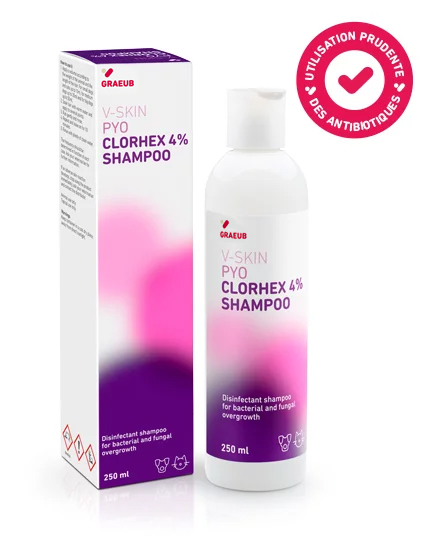LES INFECTIONS DE LA PEAU CHEZ
LES CHIENS ET LES CHATS
LES INFECTIONS DE LA PEAU CHEZ LES CHIENS ET LES CHATS
V-SKIN
PYO
CLORHEX 4% SHAMPOO
Un traitement topique efficace est la clé pour combattre les infections cutanées bactériennes et fongiques chez les chats et les chiens.
Le shampooing Clorhex 4 % présente des propriétés antiseptiques, antibactériennes et antifongiques pour nettoyer la peau et les plaies lors de dermatites et de pyodermites.
Il ne contient pas de sulfate et son parfum hypoallergénique permet de réduire la sécheresse de la peau et de la traiter délicatement. Le savon naturel très doux à base d’huile de noix de coco permet de garder le pelage propre et doux.

Points clés :
- Contient de la chlorhexidine , un composant antibactérien, désinfectant et antiseptique efficace.1, 2, 3, 4
- Tris-EDTA : composant antibiofilm qui renforce l’effet de la chlorhexidine.5, 6, 7
- Aloe vera et calendula pour apaiser et calmer la peau abîmée.8, 9, 10, 11, 12, 13, 14, 15, 16, 17, 18
Comment l’utiliser :
- Appliquez une quantité adaptée au poids de l’animal et à la longueur du poil.
- Imprégnez les poils d’eau chaude et appliquez à différents endroits.
- Frottez doucement et rincez.
- Répétez l’opération et laissez agir pendant 10 minutes.
- Rincez abondamment à l’eau propre.
- La fréquence doit être déterminée au cas par cas.
- Consultez votre vétérinaire.
- Évitez le contact avec les yeux.
Voir la vidéo d’application du produit.
Témoignages de vétérinaires
Odeur agréable, laisse le pelage duveteux et l'érythème cutané est soulagé après utilisation.

Bibliographie
- Mueller, R. S., Bergvall, K., Bensignor, E., & Bond, R. (2012). A review of topical therapy for skin infections with bacteria and yeast. Veterinary Dermatology, 23(4).
https://doi.org/10.1111/j.1365-3164.2012.01057.x - Denny, J., & Munro, C. L. (2017). Chlorhexidine Bathing Effects on Health-Care-Associated Infections. Biological Research for Nursing, 19(2).
https://doi.org/10.1177/1099800416654013 - Esumi, M., Kanda, S., Shimoura, H., Hsiao, Y. H., & Iyori, K. (2021). Preliminary evaluation of two bathing methods for the management of Malassezia overgrowth in dogs with atopic dermatitis. Veterinary Dermatology, 32(3).
https://doi.org/10.1111/vde.12948 - Wan, J. (2014). A case of methicillin-resistant Staphylococcus pseudintermedius (MRSP) pyoderma in a Labrador retriever dog. Canadian Veterinary Journal, 55(11).
- Swanson, E. A., Freeman, L. J., Seleem, M. N., & Snyder, P. W. (2014). Biofilm-infected wounds in a dog. Journal of the American Veterinary Medical Association, 244(6).
https://doi.org/10.2460/javma.244.6.699 - Wooley, R. E., & Jones, M. S. (1983). Action of EDTA-Tris and antimicrobial agent combinations on selected pathogenic bacteria. Veterinary Microbiology, 8(3).
https://doi.org/10.1016/0378-1135(83)90079-2 - Buckley, L. M., Mcewan, N. A., & Nuttall, T. (2013). Tris-EDTA significantly enhances antibiotic efficacy against multidrug-resistant Pseudomonas aeruginosa in vitro. Veterinary Dermatology, 24(5).
https://doi.org/10.1111/vde.12071 - Hekmatpou, D., Mehrabi, F., Rahzani, K., & Aminiyan, A. (2019). The effect of aloe vera clinical trials on prevention and healing of skin wound: A systematic review. In Iranian Journal of Medical Sciences (Vol. 44, Issue 1).
- Sánchez, M., González-Burgos, E., Iglesias, I., & Gómez-Serranillos, M. P. (2020). Pharmacological update properties of aloe vera and its major active constituents. In Molecules (Vol. 25, Issue 6).
https://doi.org/10.3390/molecules25061324 - Teplicki, E., Ma, Q., Castillo, D. E., Zarei, M., Hustad, A. P., Chen, J., & Li, J. (2018). The effects of aloe vera on wound healing in cell proliferation, migration, and viability. Wounds, 30(9).
- Kamr, A., Arbaga, A., El-Bahrawy, A., Elsify, A., Khaled, H., & Hassan, H. (2020). The therapeutic efficacy of Aloe vera gel ointment on staphylococcal pyoderma in dogs. Veterinary World, 13(11).
https://doi.org/10.14202/VETWORLD.2020.2371-2380 - Arbaga, A., El-Bahrawy, A., Elsify, A., Khaled, H., Hassan, H. Y., & Kamr, A. (2021). Biochemical and histopathological changes related to the topical application of Aloe vera ointment for canine pyoderma. Veterinary World, 14(5).
https://doi.org/10.14202/vetworld.2021.1354-1362 - Preethia, K. C., Kuttanb, G; Kuttan, R. (2009). Anti-inflammatory activity of flower extract of Calendula officinalis Linn. and its possible mechanism of action. Indian Journal of Experimental Biology 2009 47(2).
- Tresch, M., Mevissen, M., Ayrle, H., Melzig, M., Roosje, P.; Walkenhorst, M. (2019). Medicinal plants as therapeutic options for topical treatment in canine dermatology? A systematic review. BMC Veterinary Researc, (1).
https://doi.org/10.1186/s12917-019-1854-4 - Giostri, G. S., Novak, E. M.; Guarita-Souza, L. C. (2021). Treatment of acute wounds in hand with Calendula officinalis L.: A randomized trial. Tissue Barriers.
https://doi.org/10.1080/21688370.2021.1994822 - Cruceriu, D., Balacescu, O; Rakosy, E. (2018). Calendula officinalis: Potential Roles in Cancer Treatment and Palliative Care. In Integrative Cancer Therapies (Vol. 17, Issue 4, pp. 1068–1078). SAGE Publications Inc.
https://doi.org/10.1177/1534735418803766 - Lima, M. dos R., Lopes, A. P., Martins, C., Brito, G. A. C., Carneiro, V. C; Goes, P. (2017). The effect of Calendula officinalis on oxidative stress and bone loss in experimental periodontitis. Frontiers in Physiology, (JUN).
https://doi.org/10.3389/fphys.2017.00440 - John, R.; Jan, N. (2017). Calendula Officinalis-An Important Medicinal Plant with Potential Biological Properties.Proceedings of the Indian National Science Academy,(0).
https://doi.org/10.16943/ptinsa/2017/49126


 Nous utilisons des cookies sur notre site web pour vous offrir l’expérience la plus pertinente en enregistrant vos préférences et vos visites répétées. En cliquant sur « Tout accepter », vous consentez à l’utilisation de TOUS les cookies. Toutefois, vous pouvez consulter la rubrique « Configuration des cookies » pour fournir un consentement contrôlé.
Nous utilisons des cookies sur notre site web pour vous offrir l’expérience la plus pertinente en enregistrant vos préférences et vos visites répétées. En cliquant sur « Tout accepter », vous consentez à l’utilisation de TOUS les cookies. Toutefois, vous pouvez consulter la rubrique « Configuration des cookies » pour fournir un consentement contrôlé.